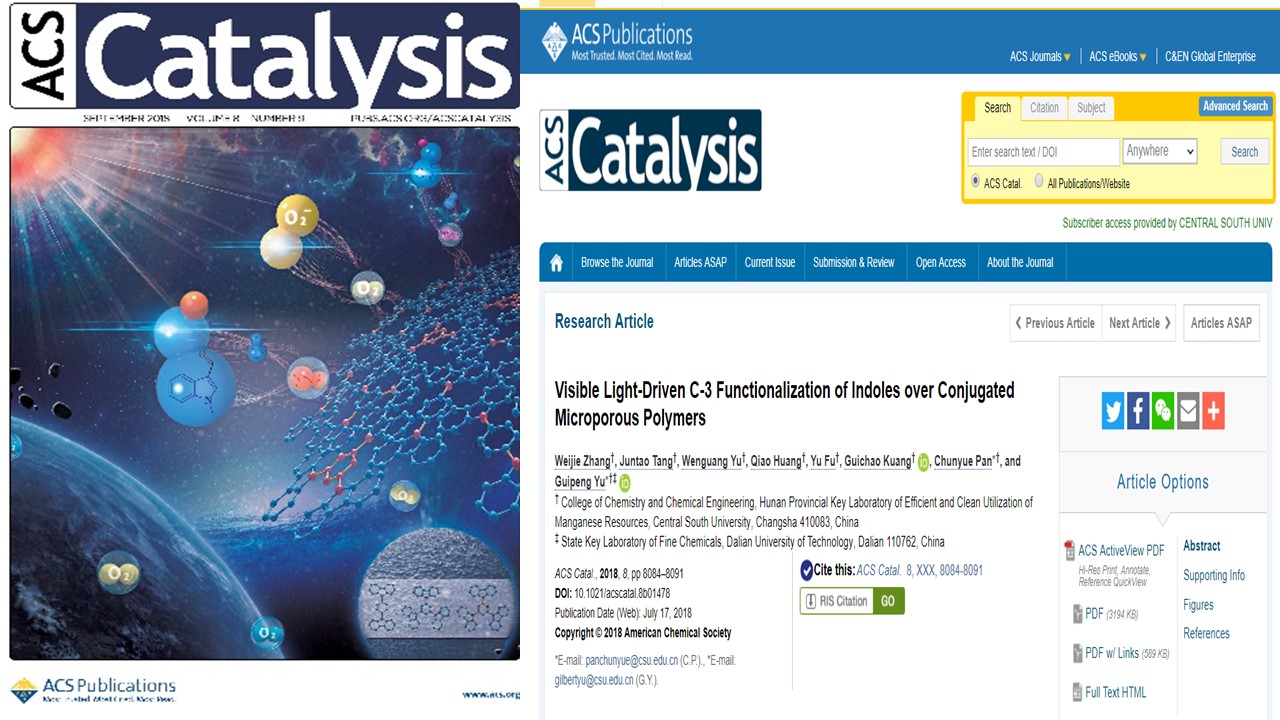Recently, ACS Catalysis, an international top chemical journal (IF=11.38), published on its cover (online) the latest research achievements on high-performance photocatalyst of the research group led by Yu Guipeng and Pan Chunyue from the School of Chemistry and Chemical Engineering of CSU. The article is titled Visible Light-Driven C-3 Functionalization of Indoles over Conjugated Microporous Polymers (ACS Catal., 2018, 8, 8084), with the School of Chemistry and Chemical Engineering of CSU as the first unit, Zhang Weijie, a 2016 doctoral student, as the first author, and Prof. Yu Guipeng and Prof. Pan Chunyue as joint corresponding authors.

The main approaches for C-3 functionalization such as formylation and thiocyanation of 3-substituted indole, an important intermediate of dyes, pesticides and drugs, are faced with a series of bottleneck problems: 1. demand on precious metal, e.g. copper and lawrencium, as catalyst; and 2. strict reaction conditions (strong oxidant or high temperature up to 120℃). Photo-catalytic oxidation enables catalysis under the action of visible light and has the advantages in reproducibility, economical efficiency and environmental friendliness. Therefore, it is of great academic significance and industrial application value to develop a metal-free, recoverable and efficient photocatalyst system to realize C-3 functionalization. In view of this, the research group has constructed through low-cost one-step carbazole monomer synthesis three functional materials of conjugated microporous polymers with high specific surface area, and successfully realized C-3 functionalization of indole ring driven by visible light and under extremely mild conditions (normal temperature), the first ever case of C-3 functionalization reaction of indole ring without heterogeneous catalysis by metal. The system has realized effective adjustment of energy level of polymer through selection of electron donor and acceptor blocks, guaranteed high-efficiency mass transfer of substrates and products by virtue of large specific surface area and unique pore structure, and achieved high photocatalytic activity and cycling stability during catalytic reaction process owing to broad absorption and excellent stability, its catalytic effect just being equivalent to that of precious metal catalyst. For this reason, this system has a good application prospect in the field of green catalysis. Besides, molecular design and research on functionalization of microcellular polymer materials are also of important research value and academic significance.
The research has been supported by the Natural Science Foundation of China as a general program (21674129) and a key program (21636010), by theNatural Science Foundation of Hunan Province-Zhuzhou United Foundation as a key program (2015JJ5015) and by CSU as an innovation driving plan (2018CX046). Prof. Tang Juntao from the School of Chemistry and Chemical Engineering and Prof. Kuang Guichao from the Powder Metallurgy Research Institute have provided an important helping hand for the research.
The article is available athttps://pubs.acs.org/doi/abs/10.1021/acscatal.8b01478
Source: School of Chemistry and Chemical Engineering











